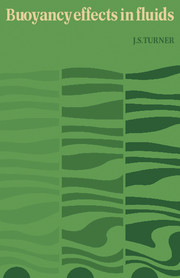Book contents
- Frontmatter
- Contents
- Preface
- 1 INTRODUCTION AND PRELIMINARIES
- 2 LINEAR INTERNAL WAVES
- 3 FINITE AMPLITUDE MOTIONS IN STABLY STRATIFIED FLUIDS
- 4 INSTABILITY AND THE PRODUCTION OF TURBULENCE
- 5 TURBULENT SHEAR FLOWS IN A STRATIFIED FLUID
- 6 BUOYANT CONVECTION FROM ISOLATED SOURCES
- 7 CONVECTION FROM HEATED SURFACES
- 8 DOUBLE-DIFFUSIVE CONVECTION
- 9 MIXING ACROSS DENSITY INTERFACES
- 10 INTERNAL MIXING PROCESSES
- Bibliography and Author Index
- Recent Publications
- Subject Index
- Plate section
3 - FINITE AMPLITUDE MOTIONS IN STABLY STRATIFIED FLUIDS
Published online by Cambridge University Press: 05 August 2012
- Frontmatter
- Contents
- Preface
- 1 INTRODUCTION AND PRELIMINARIES
- 2 LINEAR INTERNAL WAVES
- 3 FINITE AMPLITUDE MOTIONS IN STABLY STRATIFIED FLUIDS
- 4 INSTABILITY AND THE PRODUCTION OF TURBULENCE
- 5 TURBULENT SHEAR FLOWS IN A STRATIFIED FLUID
- 6 BUOYANT CONVECTION FROM ISOLATED SOURCES
- 7 CONVECTION FROM HEATED SURFACES
- 8 DOUBLE-DIFFUSIVE CONVECTION
- 9 MIXING ACROSS DENSITY INTERFACES
- 10 INTERNAL MIXING PROCESSES
- Bibliography and Author Index
- Recent Publications
- Subject Index
- Plate section
Summary
The previous chapter was based on equations of motion made linear by assuming that the amplitude of wave-like disturbances of the fluid remained infinitesimal. We now consider various large amplitude phenomena which require the inclusion of the non-linear terms for their explanation. First, some of the inviscid wave problems already treated will be extended to finite amplitude, and the essentially non-linear phenomenon of internal solitary waves will be discussed. Then various quasi-steady flows which arise in nature and in civil engineering applications will be treated, using a generalization of free surface hydraulic theory (and thus relating the properties of such flows to the waves which can form on them). Internal hydraulic jumps, the flow of a thin layer down a slope, and the nose at the front of a gravity current come under this heading. Finally we introduce the effects that viscosity and diffusion can have on slow steady motions in a stratified fluid, describing upstream wakes and boundary layers and the process of selective withdrawal.
Internal waves of finite amplitude
Interfacial waves
We refer again to the statement made in §2.1.2, that (2.1.8) is valid for finite amplitude long waves. (Cf. Lamb 1932, p. 278.) This implies that the highest point of any disturbance will move fastest, and so the forward slope of a wave of finite amplitude will tend to steepen, an effect called ‘amplitude dispersion’. This is in contrast with the result of the frequency or wavenumber dispersion previously described by (2.1.7) which is valid for general depths.
- Type
- Chapter
- Information
- Buoyancy Effects in Fluids , pp. 48 - 90Publisher: Cambridge University PressPrint publication year: 1973



